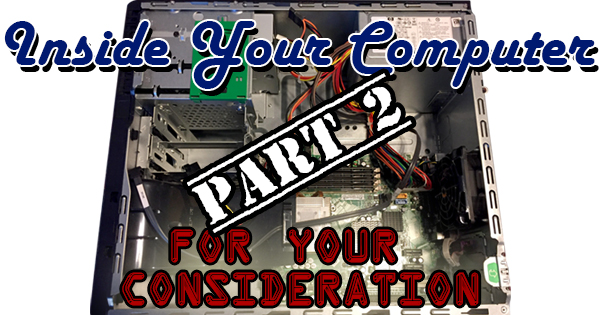
If you’ve just discovered our “Inside Your Computer” series, what took you so long? So far, we’ve covered the CPU, RAM, hard drive, optical drive, video card, and power supply. Today’s post marks the end of that series. You’re probably thinking, “What else could there be?” Well, ports, ports, and more ports for one. What about a card reader? Finally, wired vs. wireless? There are endless options that go into purchasing a computer, and my hope is that after reading this series, you’ll be armed with all the information necessary to make an informed buying decision this holiday season. It’s only six days until Christmas, so let’s not waste any time!
VGA. DVI. HDMI. USB 2.0. USB 3.0. SuperSpeed USB. What do all of these things have in common? Well, they’re all ports you might find in a computer. The first three: VGA, DVI, and HDMI are related to video. If you’re purchasing a desktop, or are interested in using an external monitor on a laptop, it’s very important to make sure that the monitor you own will plug into your new computer. VGA (Video Graphics Array) is the oldest technology. It’s designated by a blue, 15 pin, “D-shaped” port. DVI (Digital Video Interface) is easy to spot because it’s much wider than a VGA port. There are three different types of DVI: DVI-I which combines digital and analog, DVI-D which is digital only, and DVI-A which is analog only. DVI-D is most common, and you’ll see a port with up to 24 pins on it. Lastly, if you have an HDTV, you’re familiar with HDMI. HDMI represents the newest, and most impressive video on the market today. The port is basically trapezoidal in shape, and contains 19 pins.
USB devices seem to be everywhere. Flash drives, external hard drives, phones, tablets, cameras, you name it, and it probably has a USB that allows you to connect it to a computer. For my money, I want as many USB ports as possible in my computer. Recently, though, the game has changed. The standard for many years was USB 2.0. About five years ago, USB 3.0 or SuperSpeed USB was released. 3.0 allows data to be transferred about ten times faster than 2.0. To make these ports easier to spot, the rectangular ports were colored blue and labeled SS as an industry standard. Things got even faster when USB 3.1 was released in 2013. SuperSpeed USB was renamed USB 3.1 Gen 1, and this new standard called USB 3.1 Gen 2 or SuperSpeed USB 10Gbps. USB 3.1 Gen 2 is twice as fast as Gen 1, and the catchy (ahem) name SuperSpeed USB 10Gbps is so named because it can transfer files at a rate of 10 gigabytes per second. It’s important to know that older USB devices and equipment made in the USB 2.0 variant can be used in any of the faster USB ports, but they won’t achieve the same incredible speed the new devices can reach. It’s important to know about these high speed ports though in case you can take advantage of all that they have to offer.
Do you own a digital camera? How about a video camera? A GoPro? If you answered yes to any of these questions, a card reader is a good option for you. All of these devices utilize an SD card to save the information. Every camera comes with a USB (there’s that abbreviation again) cord to plug the camera into a computer, but even more convenient is the option to pop the card out of the camera and plug it into the computer! My desktop computer is almost five years old, and it contains four card readers. These will accept xD/Smart Media, SD/mini/MMC/RS/Plus/Mobile, Compact Flash I/II/MD cards, and MS/PRO/Duo/PRO Duo cards. If there are any cards out there that it can’t read let me know! When you’re away from home, nothing beats popping the card out of your camera and plugging it directly into a computer to make sure you got the shot you were looking for. It sure beats lugging all the necessary cords around.
Our last stop on our journey is the first stop for many of us: the Internet. If you’ve been around computers for a while, you remember the days of the Ethernet cord. While it seems that everyone and everything is wireless these days, wires do have their advantages. If you’re able to run an Ethernet cord from your modem/router to your computer, do it! You will always have higher Internet speeds if you’re plugged in directly. Interference will bring your Internet to a crawl, and it will be much less of an issue if the computer is hardwired. Obviously the advantage of buying a laptop is the freedom to take it wherever you want to go and not be tied to a cable. I would, however, recommend buying a laptop with the RJ-45 port that would allow you to plug it in if you so choose. Many desktops conversely offer the option to include a wireless card which would allow you to connect to the Internet wirelessly. This is a good option if you ever want to move the computer to an area of your home that isn’t wired. If you feel the need to disconnect but didn’t purchase the wireless option, there are USB (this is why you can never have enough USB ports) wireless adapters available to do the job.
Purchasing a computer is a large financial decision for most of us. Why then are so many of us so cavalier about making the purchase? Take the time to learn about what you have and what you’re looking for. Don’t rely too much on the pimply faced kid at Best Buy!
